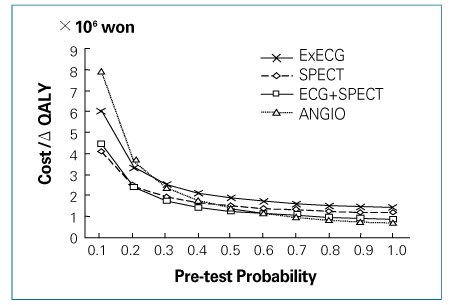 |
 |
- Search
| J Korean Med Assoc > Volume 47(1); 2004 > Article |
Abstract
Diagnostic strategies for coronary artery disease are diverse and include ① exercise EKG to coronary angiography, ② myocardial SPECT to coronary angiography, ③ dobutamine or exercise echocardiography to coronary angiography, and ④ direct coronary angiography. Cost-effectiveness analysis can be performed considering ① that the cost should include the costs of the diagnostic tests themselves, the cost of not-diagnosing the patients, the final test costs on false positive patients, and the cost to treat complications and ② that the effect should include quality-adjusted life year (QALY) with the fraction of proper diagnosis influenced by the diagnostic performance of the initial non-invasive tests. Based on the prior cost-effectiveness analysis, the pre-test likelihood affected most of the cost-effectiveness of a diagnostic strategy. Direct angiography was most cost-effective when the pre-test likelihood was high (>60%), while SPECT with or without a prior exercise EKG to angiography was most cost-effective when the pre-test likelihood was intermediate or low. Compared to stress echocardiography, stress myocardial SPECT was more cost-effective when the likelihood was moderate or high. While the prognostic significance of negative (including false-negative) cases was important to maintain cost-effectiveness of a strategy, myocardial SPECT to coronary angiography was the most cost-effective method to diagnose coronary artery disease.
References
2. Lee DS, Jang MJ, Cheon GJ, Chung JK, Lee MC. Comparison of the cost-effectiveness of stress myocardial SPECT and stress echocardiography in suspected coronary artery disease considering the prognostic value of false-negative results. J Nucl Cardiol 2002;9:515-522.
3. Patterson RE, Eisner RL, Horowitz SF. Comparison of cost-effectiveness and utility of exercise ECG, single photon emission computed tomography, positron emission tomography, and coronary angiography for diagnosis of coronary artery disease. Circulation 1995;91:54-65.
- TOOLS
-
METRICS

-
- 1 Crossref
- Scopus
- 975 View
- 5 Download
-
Related articles in
J Korean Med Assoc -
Pathogenesis of Coronary Atherosclerosis2002 July;45(7)
Diagnosis of Coronary Artery Disease2004 August;47(8)
Medical Management of Coronary Artery Disease2004 August;47(8)
Surgical Treatment of Coronary Artery Disease2004 August;47(8)







